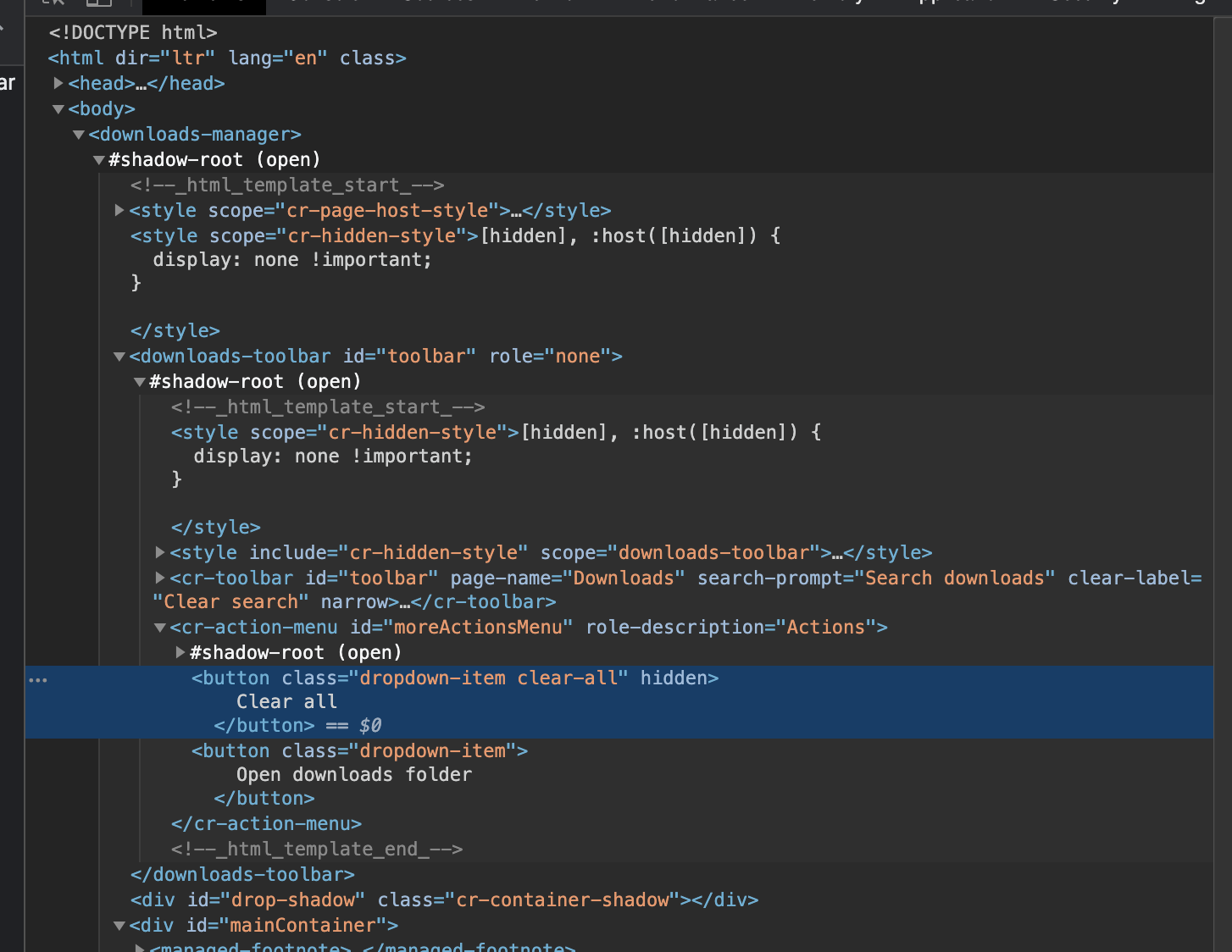README
query-selector-shadow-dom
querySelector that can pierce Shadow DOM roots without knowing the path through nested shadow roots. Useful for automated testing of Web Components e.g. with Selenium, Puppeteer.
// available as an ES6 module for importing in Browser environments
import { querySelectorAllDeep, querySelectorDeep } from 'query-selector-shadow-dom';
What is a nested shadow root?
 You can see that
You can see that .dropdown-item:not([hidden]) (Open downloads folder) is several layers deep in shadow roots, most tools will make you do something like
document.querySelector("body > downloads-manager").shadowRoot.querySelector("#toolbar").shadowRoot.querySelector(".dropdown-item:not([hidden])")
EW!
with query-selector-shadow-dom:
import { querySelectorAllDeep, querySelectorDeep } from 'query-selector-shadow-dom';
querySelectorDeep(".dropdown-item:not([hidden])");
API
- querySelectorAllDeep - mirrors
querySelectorAllfrom the browser, will return anArrayof elements matching the query - querySelectorDeep - mirrors
querySelectorfrom the browser, will return thefirstmatching element of the query.
Both of the methods above accept a 2nd parameter, see section Provide alternative node. This will change the starting element to search from i.e. it will find ancestors of that node that match the query.
Plugins
WebdriverIO
This plugin implements a custom selector strategy: https://webdriver.io/docs/selectors.html#custom-selector-strategies
// make sure you have selenium standalone running
const { remote } = require('webdriverio');
const { locatorStrategy } = require('query-selector-shadow-dom/plugins/webdriverio');
(async () => {
const browser = await remote({
logLevel: 'error',
path: '/wd/hub',
capabilities: {
browserName: 'chrome'
}
})
// The magic - registry custom strategy
browser.addLocatorStrategy('shadow', locatorStrategy);
// now you have a `shadow` custom locator.
// All elements on the page
await browser.waitUntil(() => browser.custom$("shadow", ".btn-in-shadow-dom"));
const elements = await browser.$("*");
const elementsShadow = await browser.custom$("shadow", "*");
console.log("All Elements on Page Excluding Shadow Dom", elements.length);
console.log("All Elements on Page Including Shadow Dom", elementsShadow.length);
await browser.url('http://127.0.0.1:5500/test/')
// find input element in shadow dom
const input = await browser.custom$('shadow', '#type-to-input');
// type to input ! Does not work in firefox, see above.
await input.setValue('Typed text to input');
// Firefox workaround
// await browser.execute((input, val) => input.value = val, input, 'Typed text to input')
await browser.deleteSession()
})().catch((e) => console.error(e))
How is this different to shadow$
shadow$ only goes one level deep in a shadow root.
Take this example.
 You can see that
You can see that .dropdown-item:not([hidden]) (Open downloads folder) is several layers deep in shadow roots, but this library will find it, shadow$ would not.
You would have to construct a path via css or javascript all the way through to find the right element.
const { remote } = require('webdriverio')
const { locatorStrategy } = require('query-selector-shadow-dom/plugins/webdriverio');
(async () => {
const browser = await remote({capabilities: {browserName: 'chrome'}})
browser.addLocatorStrategy('shadow', locatorStrategy);
await browser.url('chrome://downloads')
const moreActions = await browser.custom$('shadow', '#moreActions');
await moreActions.click();
const span = await browser.custom$('shadow', '.dropdown-item:not([hidden])');
const text = await span.getText()
// prints `Open downloads folder`
console.log(text);
await browser.deleteSession()
})().catch((e) => console.error(e))
Known issues
https://webdriver.io/blog/2019/02/22/shadow-dom-support.html#browser-support
From the above, firefox
setValuedoes NOT currently work.. A workaround for now is to use a custom command (or method on your component object) that sets the input field's value via browser.execute(function).Safari pretty much doesn't work, not really a surprise.
There are some webdriver examples available in the examples folder of this repository. WebdriverIO examples
Puppeteer
There are some puppeteer examples available in the examples folder of this repository.
Playwright
Update: as of Playwright v0.14.0 their CSS and text selectors work with shadow Dom out of the box, you don't need this library anymore for Playwright.
Playwright works really nicely with this package.
This module exposes a playwright selectorEngine: https://github.com/microsoft/playwright/blob/master/docs/api.md#selectorsregisterenginefunction-args
const { selectorEngine } = require("query-selector-shadow-dom/plugins/playwright");
const playwright = require('playwright');
await selectors.register('shadow', createTagNameEngine);
...
await page.goto('chrome://downloads');
// shadow= allows a css query selector that automatically pierces shadow roots.
await page.waitForSelector('shadow=#no-downloads span', {timeout: 3000})
For a full example see: https://github.com/Georgegriff/query-selector-shadow-dom/blob/master/examples/playwright
Protractor
This project provides a Protractor plugin, which can be enabled in your protractor.conf.js file:
exports.config = {
plugins: [{
package: 'query-selector-shadow-dom/plugins/protractor'
}],
// ... other Protractor-specific config
};
The plugin registers a new locator - by.shadowDomCss(selector /* string */), which can be used in regular Protractor tests:
element(by.shadowDomCss('#item-in-shadow-dom'))
The locator also works with Serenity/JS tests that use Protractor under the hood:
import 'query-selector-shadow-dom/plugins/protractor';
import { Target } from '@serenity-js/protractor'
import { by } from 'protractor';
const ElementOfInterest = Target.the('element of interest')
.located(by.shadowDomCss('#item-in-shadow-dom'))
See the end-to-end tests for more examples.
Examples
Provide alternative node
// query from another node
querySelectorShadowDom.querySelectorAllDeep('child', document.querySelector('#startNode'));
// query an iframe
querySelectorShadowDom.querySelectorAllDeep('child', iframe.contentDocument);
This library does not allow you to query across iframe boundaries, you will need to get a reference to the iframe you want to interact with.
If your iframe is inside of a shadow root you could cuse querySelectorDeep to find the iframe, then pass the contentDocument into the 2nd argument of querySelectorDeep or querySelectorAllDeep.
Chrome downloads page
In the below examples the components being searched for are nested within web components shadowRoots.
// Download and Paste the lib code in dist into chrome://downloads console to try it out :)
console.log(querySelectorShadowDom.querySelectorAllDeep('downloads-item:nth-child(4) #remove'));
console.log(querySelectorShadowDom.querySelectorAllDeep('#downloads-list .is-active a[href^="https://"]'));
console.log(querySelectorShadowDom.querySelectorDeep('#downloads-list div#title-area + a'));
Shady DOM
If using the polyfills and shady DOM, this library will still work.
Importing
- Shipped as an ES6 module to be included using a bundler of your choice (or not).
- ES5 version bundled ontop the window as
window.querySelectorShadowDomavailable for easy include into a test framework
Running the code locally
npm install
Running the tests
npm test
Running the tests in watch mode
npm run watch
Running the build
npm run build
